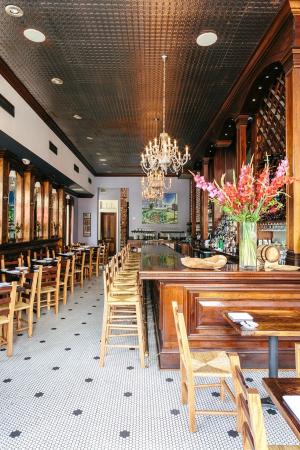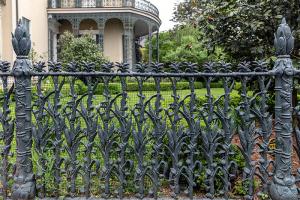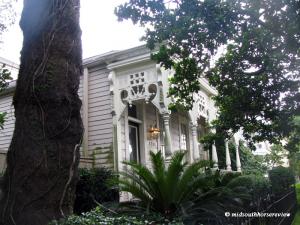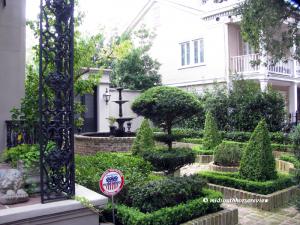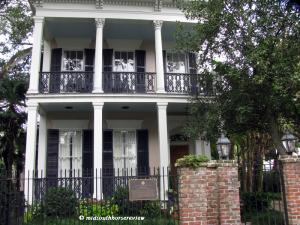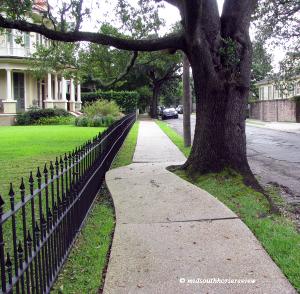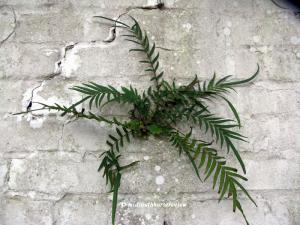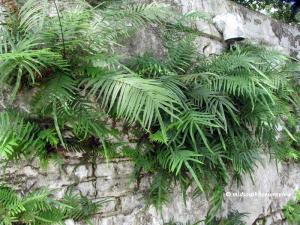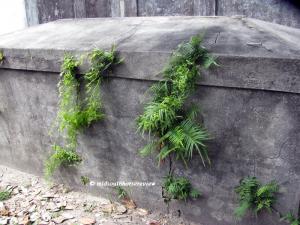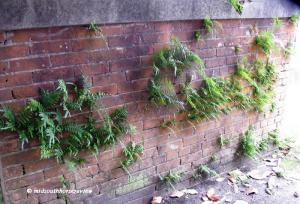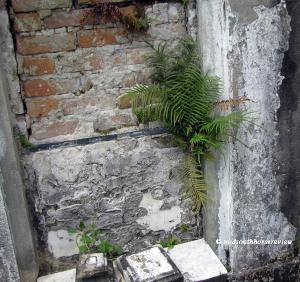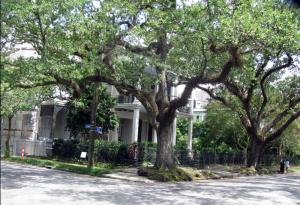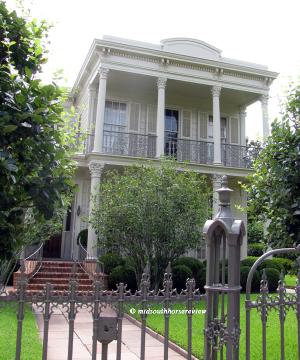By Nancy Brannon
On our visit to New Orleans in early August, a tour of the Garden District, with its large live oak lined streets and serene atmosphere, in contrast with the vibrant Vieux Carré, was definitely on our tour list. We joined a walking tour that began in the Lafayette Cemetery No. 1, established in 1833 and still receiving burials.
As a fern lover, the first things I noticed were the ferns growing out of brick and mason walls – and even tombs! It was such a fascinating sight that I took several photos and then looked up the name and origin of this unique fern.
The Loyola University of New Orleans Center for Environmental Communication had the answers I was looking for. It is known locally as the Cemetery or Cistern Fern because of its habit in growing in these two moisture retaining areas. But mainly it likes to grow in substrates rich in lime (calcium carbonate), which the New Orleans soils are lacking. But mortar, especially the eighteenth and nineteenth century clam and oyster shell based variety, provides just the nutrients that the ferns need.
The real name of this fern species is Ladder Brake Fern (Pteris vittatus) and it is native to southeastern Asia. Its range in the U.S. extends from southwestern Louisiana to South Carolina and southward throughout Florida. But how did it get from southeastern Asia to the U.S.?
An intriguing explanation for its arrival accounts for its great abundance in cemeteries. “As the story goes, vases received from southeastern Asia were securely packaged in excelsior [softwood shavings used for packing fragile goods], which was replete with Ladder Brake spores. As the vases were unwrapped and placed in cemeteries and courtyards, the spores were introduced to favorable habitat and germinated, thus beginning the life cycle of the Ladder Brake in the New World.”
(Source: http://www.loyno.edu/lucec/natural-history-writings/cemetery-fern)
More about the cemetery
One first notices the above-ground burial tombs, primarily because the water table is so high that caskets buried below ground would soon rise out of the ground. Above-ground tombs are practical, too. Embalming was not used in the U.S. until after the Civil War. When the deceased was placed in the tomb without embalming, the great heat inside these brick oven-like tombs caused the process of disintegration to accelerate. Families must wait one year and a day to put another deceased member in the tomb, because by that time, there is room to place another body. Some tombs can contain up to 35 family members.
More about the Garden District
Following the Louisiana Purchase in 1803, Protestant Americans began to settle in New Orleans and built houses upriver from the French Quarter at a site of a former plantation in the city of Lafayette, incorporated into New Orleans in 1852. In the 1850s when the city was booming, wealthy merchants built beautiful mansions in the area that is now known as the Garden District. Known for its architectural and cultural significance, it was declared a National Historic Landmark in 1974.
Among the many old mansions that we saw (from the outside only) were houses now owned by Sandra Bullock, Archie Manning, and John Goodman.
Sandra Bullock’s home is a Swiss Germanic Chalet style, built in 1867. It was designed by Architect William Freret for James Eustis, a onetime U.S. Senator.
The Manning mansion on First Street is home of the former New Orleans Saints quarterback Archie Manning. The family are still full time residents and it was the childhood home of Peyton, Eli, and Cooper Manning.
Actor John Goodman owns a house on Coliseum Street. Before Goodman bought the home, it belonged to Trent Reznor, the singer of Nine Inch Nails. The original name of the house is the Joseph Merrick Jones House, built in 1850 in the Greek Revival style of architecture.
Also on Coliseum Street is a row of five nearly identical double-gallery townhouses in Greek Revival style erected in 1861 by New Orleans architect William A. Freret, cousin of 19th century architect James Freret, as a speculative building project. But, of course, the start of the Civil War led to an exodus of Garden District residents, many of whom had moved there from northern states, and the Coliseum Street project failed miserably. Today the houses are called “Freret’s Folly.”
The Carroll-Crawford House on First Street, with its Italianate style and cast-iron balconies, was built in 1869 for Joseph Carroll, a Virginia cotton merchant.
One of the most unique fences in front a mansion is wrought iron corn stalk fence at Colonel Short’s Villa on Fourth Street, also known as the Short-Favrot House. The fence was made in the late 1850s and features a repeating, central cornstalk pattern and fence posts with pumpkin bases, tree trunks, and morning glory vines. There two other full examples of this fence: one on Royal Street in the French Quarter near the Cornstalk Hotel and the other at the Banning Museum in Wilmington, California.
Our Mother of Perpetual Help Chapel is a three story Greek-Italianate Revival mansion originally designed in 1857 for wealthy coffee importer Henry T. Daily Lonsdale. At the time, it was the tallest structure in the Garden District. From 1829 to 1953 the house was a Catholic Girls School. Most recently, Anne Rice used it as the setting for her novel Violin and Nicholas Cage owned it for a while.
Henry Lonsdale is attributed with adding chicory to coffee in New Orleans to make his limited supply of coffee last during the war years, as the Union naval blockade prevented his importation of coffee. Of course, coffee with chicory is still a favorite among New Orleans residents and visitors.
However, there is a much larger history of blending coffee with chicory dating to Holland around 1750, and further back to ancient Egypt.
In the 1850s, New Orleans directories listed more than 500 coffee houses. The first was established by former slave Rose Nicaud, who, with her earnings from selling coffee, opened the first coffee stall in the French Market and sold café-au-lait.
And if there’s a book store, we’re going to stop. The Garden District Book Shop is located in a building that once housed the South’s first ice skating rink, called the Rink. The Rink was built in 1884 when New Orleans hosted the world Cotton Centennial Exposition. The book shop has a special section devoted to the gothic novels of renowned New Orleans writer Anne Rice. Rice always began her book tours here, including one time when she arrived in a quilted coffin – just for “special effects.”
Rice had an interesting relationship with mansions in the Garden District, too. The mansion where she lived was the Greek Revival house at Chestnut and First known as Rosegate. But over the years that she lived in the Garden District, she bought a collection of Garden District houses, renovated and then sold them. After her husband died in 2002, Rice left the Garden District in 2004 to live near her only child in California. Learn more about Anne Rice at: http://annerice.com/
For lunch, we checked out Commander’s Palace Restaurant, but it was fully booked. Reservations are required and it has a strict dress code. It was built in 1883 for Emil Commander to be run as a restaurant. It is now considered to be one of the best restaurants in the United States and has been owned by the Brennan family since 1974. We had recommended to us Coquette on Magazine Street at Washington Avenue, in a building that was built in the late 1880s and was formerly a residence, a grocery store, and auto parts store.
On our visit to New Orleans in early August, a tour of the Garden District, with its large live oak lined streets and serene atmosphere, in contrast with the vibrant Vieux Carré, was definitely on our tour list. We joined a walking tour that began in the Lafayette Cemetery No. 1, established in 1833 and still receiving burials.
As a fern lover, the first things I noticed were the ferns growing out of brick and mason walls – and even tombs! It was such a fascinating sight that I took several photos and then looked up the name and origin of this unique fern.
The Loyola University of New Orleans Center for Environmental Communication had the answers I was looking for. It is known locally as the Cemetery or Cistern Fern because of its habit in growing in these two moisture retaining areas. But mainly it likes to grow in substrates rich in lime (calcium carbonate), which the New Orleans soils are lacking. But mortar, especially the eighteenth and nineteenth century clam and oyster shell based variety, provides just the nutrients that the ferns need.
The real name of this fern species is Ladder Brake Fern (Pteris vittatus) and it is native to southeastern Asia. Its range in the U.S. extends from southwestern Louisiana to South Carolina and southward throughout Florida. But how did it get from southeastern Asia to the U.S.?
An intriguing explanation for its arrival accounts for its great abundance in cemeteries. “As the story goes, vases received from southeastern Asia were securely packaged in excelsior [softwood shavings used for packing fragile goods], which was replete with Ladder Brake spores. As the vases were unwrapped and placed in cemeteries and courtyards, the spores were introduced to favorable habitat and germinated, thus beginning the life cycle of the Ladder Brake in the New World.”
(Source: http://www.loyno.edu/lucec/natural-history-writings/cemetery-fern)
More about the cemetery
One first notices the above-ground burial tombs, primarily because the water table is so high that caskets buried below ground would soon rise out of the ground. Above-ground tombs are practical, too. Embalming was not used in the U.S. until after the Civil War. When the deceased was placed in the tomb without embalming, the great heat inside these brick oven-like tombs caused the process of disintegration to accelerate. Families must wait one year and a day to put another deceased member in the tomb, because by that time, there is room to place another body. Some tombs can contain up to 35 family members.
More about the Garden District
Following the Louisiana Purchase in 1803, Protestant Americans began to settle in New Orleans and built houses upriver from the French Quarter at a site of a former plantation in the city of Lafayette, incorporated into New Orleans in 1852. In the 1850s when the city was booming, wealthy merchants built beautiful mansions in the area that is now known as the Garden District. Known for its architectural and cultural significance, it was declared a National Historic Landmark in 1974.
Among the many old mansions that we saw (from the outside only) were houses now owned by Sandra Bullock, Archie Manning, and John Goodman.
Sandra Bullock’s home is a Swiss Germanic Chalet style, built in 1867. It was designed by Architect William Freret for James Eustis, a onetime U.S. Senator.
The Manning mansion on First Street is home of the former New Orleans Saints quarterback Archie Manning. The family are still full time residents and it was the childhood home of Peyton, Eli, and Cooper Manning.
Actor John Goodman owns a house on Coliseum Street. Before Goodman bought the home, it belonged to Trent Reznor, the singer of Nine Inch Nails. The original name of the house is the Joseph Merrick Jones House, built in 1850 in the Greek Revival style of architecture.
Also on Coliseum Street is a row of five nearly identical double-gallery townhouses in Greek Revival style erected in 1861 by New Orleans architect William A. Freret, cousin of 19th century architect James Freret, as a speculative building project. But, of course, the start of the Civil War led to an exodus of Garden District residents, many of whom had moved there from northern states, and the Coliseum Street project failed miserably. Today the houses are called “Freret’s Folly.”
The Carroll-Crawford House on First Street, with its Italianate style and cast-iron balconies, was built in 1869 for Joseph Carroll, a Virginia cotton merchant.
One of the most unique fences in front a mansion is wrought iron corn stalk fence at Colonel Short’s Villa on Fourth Street, also known as the Short-Favrot House. The fence was made in the late 1850s and features a repeating, central cornstalk pattern and fence posts with pumpkin bases, tree trunks, and morning glory vines. There two other full examples of this fence: one on Royal Street in the French Quarter near the Cornstalk Hotel and the other at the Banning Museum in Wilmington, California.
Our Mother of Perpetual Help Chapel is a three story Greek-Italianate Revival mansion originally designed in 1857 for wealthy coffee importer Henry T. Daily Lonsdale. At the time, it was the tallest structure in the Garden District. From 1829 to 1953 the house was a Catholic Girls School. Most recently, Anne Rice used it as the setting for her novel Violin and Nicholas Cage owned it for a while.
Henry Lonsdale is attributed with adding chicory to coffee in New Orleans to make his limited supply of coffee last during the war years, as the Union naval blockade prevented his importation of coffee. Of course, coffee with chicory is still a favorite among New Orleans residents and visitors.
However, there is a much larger history of blending coffee with chicory dating to Holland around 1750, and further back to ancient Egypt.
In the 1850s, New Orleans directories listed more than 500 coffee houses. The first was established by former slave Rose Nicaud, who, with her earnings from selling coffee, opened the first coffee stall in the French Market and sold café-au-lait.
And if there’s a book store, we’re going to stop. The Garden District Book Shop is located in a building that once housed the South’s first ice skating rink, called the Rink. The Rink was built in 1884 when New Orleans hosted the world Cotton Centennial Exposition. The book shop has a special section devoted to the gothic novels of renowned New Orleans writer Anne Rice. Rice always began her book tours here, including one time when she arrived in a quilted coffin – just for “special effects.”
Rice had an interesting relationship with mansions in the Garden District, too. The mansion where she lived was the Greek Revival house at Chestnut and First known as Rosegate. But over the years that she lived in the Garden District, she bought a collection of Garden District houses, renovated and then sold them. After her husband died in 2002, Rice left the Garden District in 2004 to live near her only child in California. Learn more about Anne Rice at: http://annerice.com/
For lunch, we checked out Commander’s Palace Restaurant, but it was fully booked. Reservations are required and it has a strict dress code. It was built in 1883 for Emil Commander to be run as a restaurant. It is now considered to be one of the best restaurants in the United States and has been owned by the Brennan family since 1974. We had recommended to us Coquette on Magazine Street at Washington Avenue, in a building that was built in the late 1880s and was formerly a residence, a grocery store, and auto parts store.
